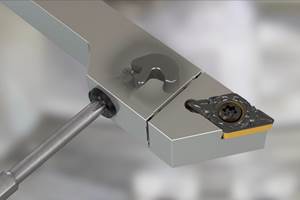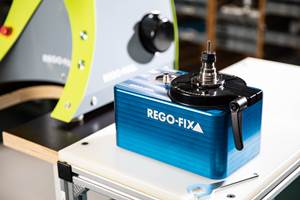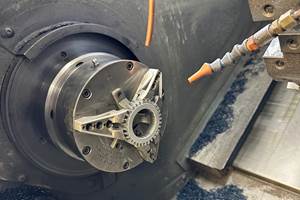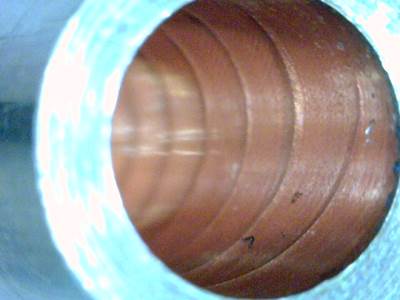Drilling with Modulation Delivers Pecks for Free
A system for center drilling on Swiss-types and other small lathes oscillates the drill up to 1,000 times per second. Cycle time, part quality and predictability all improve.
Share






This animation illustrates MAM.
Almost anyone who has ever drilled a hole knows the value of a peck drilling cycle. Periodically backing up the drill helps manage both chips and heat within a deep hole. In recent years, Purdue University researchers have worked to develop a technology based on a straightforward idea: If pecking every few seconds during the drilling cycle is good, then pecking hundreds of times per second might be dramatically better still.
Modulation Assisted Machining (MAM) is the commercial name for this now-patented technology—sold by a company incubated by the university, M4 Sciences of West Lafayette, Indiana. Thanks in part to funding from the National Science Foundation and Indiana’s 21st Century Fund, M4 Sciences was able to take an idea that had been proven in laboratory settings and translate it into a self-contained product that can be installed and applied on production CNC lathes.
So far, lathes are the only target for this technology, which applies strictly to center drilling applications. The company’s “TriboMAM” modulating unit loads in the turning machine’s workzone like a toolholder and connects to a small, independent controller. Accommodating drills up to 5 mm in diameter, the system is best suited for compact CNC machines, particularly Swiss-type lathes. For these machines, the technology offers the potential for dramatically more productive drilling—particularly in titanium and other hard metals.
With MAM, the peck drilling cycle is free. The TriboMAM unit oscillates the drill as it cuts, making the peck continuous. This does away with the delay of programmed peck cycles, while also permitting more aggressive feeds, says Jeff Bougher, president of M4 Sciences. Typically, the company promises drilling cycle time reductions of at least 50 percent.
The minutely controlled pecks occur at frequencies ranging to 1,000 times per second. Actual frequency and amplitude are both determined by the system’s controller, based on drilling parameters input by the operator (speed, feed rate, number of drill flutes and drill diameter). Beyond cycle time improvement, Mr. Bougher says the benefits of the oscillation include the following:
• Better lubrication. Continuous oscillation leaves room for the lubricant to get into the cut, he says. Keeping lubricant at the cutting edge makes through-tool coolant even more effective.
• Better chip evacuation. Chips are small thanks to the rapid pecks. This ultimately produces more consistently accurate holes because chips no longer get bound up with the tool to distort the hole’s shape.
• Consistently shaped chips, which lead to a more consistent drilling process overall.
This final benefit might well be the most valuable, Mr. Bougher says. Manufacturers of high-value parts, such as aircraft fuel system components and orthopedic screws, increasingly do not find their efficiency gains solely by running faster. The savings also come from engineering a process that runs with less human oversight. Doing this requires machining operations that perform predictably—cut after cut and hour after hour.
MAM’s ability to control the chip contributes to this predictability, he says. What’s more, users get this consistency and predictability essentially for free, because there is no need to reduce cycle time to make the cutting more consistent.
Related Content
Quick-Change Tool Heads Reduce Setup on Swiss-Type Turning Centers
This new quick-change tooling system enables shops to get more production from their Swiss turning centers through reduced tool setup time and matches the performance of a solid tool.
Read MoreFive Common Mistakes Shops Make with ER Collets (And How to Prevent Them)
Collets play a crucial role in the machining process, so proper tool assembly and maintenance is important. Here are five potential pitfalls to avoid when using ER collets.
Read MoreBriquetting Manufacturer Tools Up for Faster Turnaround Times
To cut out laborious manual processes like hand-grinding, this briquette manufacturer revamped its machining and cutting tool arsenal for faster production.
Read MoreChuck Jaws Achieve 77% Weight Reduction Through 3D Printing
Alpha Precision Group (APG) has developed an innovative workholding design for faster spindle speeds through sinter-based additive manufacturing.
Read MoreRead Next
Video: Modulation Assisted Machining
This footage shows the effect of a techology that speeds and simplifies center drilling by oscillating the drill through many pecks per second.
Read MoreAMRs Are Moving Into Manufacturing: 4 Considerations for Implementation
AMRs can provide a flexible, easy-to-use automation platform so long as manufacturers choose a suitable task and prepare their facilities.
Read MoreMachine Shop MBA
Making Chips and 91ÊÓƵÍøÕ¾ÎÛ are teaming up for a new podcast series called Machine Shop MBA—designed to help manufacturers measure their success against the industry’s best. Through the lens of the Top Shops benchmarking program, the series explores the KPIs that set high-performing shops apart, from machine utilization and first-pass yield to employee engagement and revenue per employee.
Read More






















